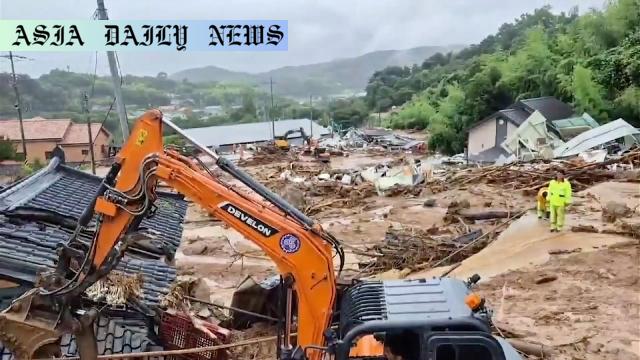Torrential Rain: The death toll from heavy rainfall in South Korea has risen to 14, with 12 people still missing as rescue efforts continue.
Heavy rainfall in South Korea has caused 14 deaths and 12 missing.
800mm rainfall over 5 days caused flooding and landslides.
Over 2,000 people were forced to evacuate their homes.
Authorities continue search and rescue efforts amid devastation.

Torrential Rain Devastates South Korea
The recent torrential rain that swept across South Korea has caused significant devastation, leaving 14 people dead and 12 others missing. The rainfall, which began on Wednesday and persisted into the weekend, created a crisis that has not only taken lives but also displaced thousands of citizens. As of 10 a.m. Sunday, the Ministry of the Interior and Safety confirmed these grim statistics and addressed the urgent need for ongoing relief efforts across affected regions.
Particularly hard-hit were mountainous regions in the country’s northern and southern provinces. Sancheong, located in South Gyeongsang Province, recorded approximately 800 millimeters of rain over a five-day period starting Wednesday. Such extreme conditions triggered severe flooding and landslides, wreaking havoc on infrastructure and dismantling communities. The death toll in this region stands at eight, with six individuals currently unaccounted for. The natural disaster also displaced approximately 2,000 residents, who were forced to flee for their safety as homes became engulfed by water or buried under debris.
Localized Tragedies Amplifying the Disaster
Beyond the central impact zones, localized incidents further escalated the tragedy. In Gapyeong, Gyeonggi Province, two fatalities occurred as homes were reduced to rubble, and a vehicle was swept away in the deluge. Four individuals in this region remain missing, highlighting the relentless danger posed by rapidly changing weather patterns. Responders are doubling down on rescue operations but face significant challenges given the magnitude of destruction and the ongoing threat of additional rainfall.
The situation has brought into sharp focus the limitations of existing disaster management systems in South Korea. While the government has deployed search and rescue teams, residents and critics alike are questioning whether preemptive measures and infrastructure investment could have mitigated the worst of these outcomes. Prolonged rainy seasons, amplified by the impacts of climate change, continue to challenge even the best-prepared nations. For South Korea, this disaster serves as both a tragedy and a wake-up call for improved preparedness and response mechanisms.
The Role of Climate Change and Future Preparedness
Experts indicate that the intensity of heavy rainfall in South Korea, alongside other regions globally, may be tied to the broader effects of climate change. Warmer ocean temperatures contribute to increased moisture in the air, leading to prolonged periods of rain. As such events become more frequent, nations must prioritize sustainable disaster prevention plans, adaptable infrastructure, and community education to mitigate risks effectively. South Korea’s latest tragedy underlines not only the human toll of extreme weather but also the pressing need for coordinated global action in combating climate change.
Meanwhile, for the affected residents, the immediate priority is survival and rehabilitation. Relief agencies are collaborating to provide temporary shelter, food, and health services to evacuees. However, the journey toward rebuilding their lives is expected to be long and arduous, necessitating immense support from both national and international communities.
Conclusion
The torrential rain that struck South Korea serves as a poignant reminder of nature’s unprecedented power and mankind’s inevitable vulnerability. With 14 lives lost, 12 individuals missing, and thousands displaced, the disaster demands not just national reflection but also proactive global initiatives to address the looming crisis of climate change. As South Korea grapples with the aftermath, the lessons learned must echo far and wide, inspiring a collective effort toward resilience and a sustainable future.



Commentary
The Human Cost of Torrential Rain in South Korea
Natural disasters serve as stark reminders of the fragile balance between humanity and nature. The torrential rain that engulfed South Korea over the past week is a tragedy of both heart-wrenching proportions and invaluable lessons. While specific areas, particularly in mountainous provinces, bore the brunt of the disaster, the impact reverberates far beyond the affected zones. Lives have been lost, families displaced, and entire communities left in despair as they reckon with the enormity of their loss.
The Need for Immediate and Long-term Action
Amid the devastation, the role of governments, disaster relief agencies, and even individuals becomes pivotal. Immediate actions such as rescue, medical assistance, and providing temporary shelters can mitigate further suffering. However, as we examine the broader picture, it becomes clear that addressing the root causes of increasingly extreme weather events is essential for long-term survival. Nations, particularly those prone to natural disasters, must innovate and invest in advanced weather forecasting systems, climate-resilient infrastructure, and education campaigns to prepare communities at risk.
Equally important is the global acknowledgment of climate change as a catalyst for disasters of such magnitude. The loss of lives and livelihoods in South Korea isn’t an isolated incident but part of a growing pattern attributable to global warming. Collective international initiatives are crucial to combating climate-induced hazards and ensuring sustainable growth worldwide.
Finding Resilience Through Unity
Despite the grim circumstances, hope lies in the resilience demonstrated in times of crisis. Communities often step up to support each other, finding strength in solidarity. Experiences drawn from such tragedies should compel societies to unite across borders, share resources, and develop forward-looking strategies that safeguard humanity’s collective future. South Korea’s recent disaster is a somber reminder of our fragility, but it can also serve as a beacon for the urgent need for global cooperation and resilience-building.